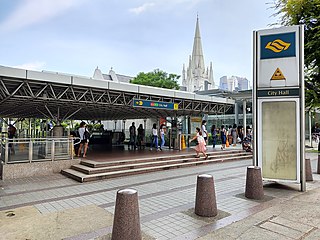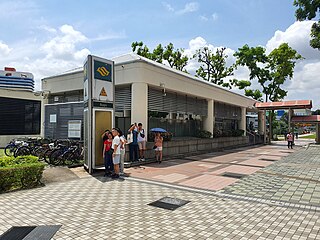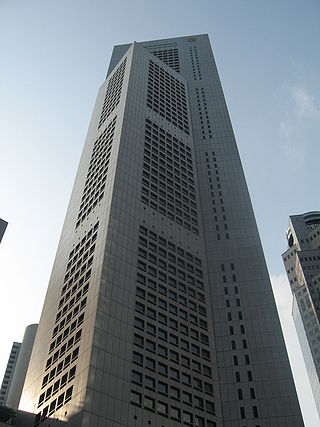
City Hall MRT station is an underground Singapore Mass Rapid Transit (MRT) interchange station on the North–South line (NSL) and East–West line (EWL). Situated in the Downtown Core district, it is underneath Stamford Road near the road junctions with North Bridge Road and St Andrew's Road. The station is near landmarks such as the former City Hall, Raffles City, the Padang, St Andrew's Cathedral and the Cenotaph.

Raffles Place is the centre of the Financial District of Singapore and is located south of the mouth of the Singapore River. It was first planned and developed in the 1820s as Commercial Square to serve as the hub of the commercial zone of Singapore in Raffles Town Plan. It was renamed Raffles Place in 1858 and is now the site of a number of major banks. It is located in the Downtown Core within the Central Area, and features some of the tallest buildings and landmarks of the country.

The Tun Abdul Razak Complex, formerly the PenangUrban Centre, is a civic complex within the central business district of George Town in the Malaysian state of Penang. At the time of its completion in 1985, Komtar Tower, at 231.7 metres (760 ft), was the second tallest building in Asia and the tallest in Southeast Asia until 1986 when it was surpassed by One Raffles Place in Singapore. Other buildings in the complex include a hotel building, four shopping malls, an urban park and a central transportation hub. The complex contains 1,420,000 square feet (132,000 m2) of office and retail space on a 27-acre (11 ha) superblock. It currently houses the administrative offices of the Penang state government and the chief minister of Penang.

Republic Plaza is a skyscraper in Downtown Core, Singapore. It comprises two towers and a 10-storey podium. The first tower, Republic Plaza I, has 66 floors and a height of 280 metres (920 ft), and has a varying octagonal-cross section, while its interior allows for flexible space usage by tenants. The second tower, Republic Plaza II, is 23 stories tall, while the podium contains a three-floor retail area.

Parkway Parade is a suburban shopping centre in Marine Parade, Singapore. Officially opened in March 1984, it has a 17-floor office tower and a seven-storey shopping mall with a basement. Developed by Parkway Holdings, the company sold the building to Asia Pacific Investment Company in 2000. The mall is managed by Lendlease.

The Nicoll Highway collapse occurred in Singapore on 20 April 2004 at 3:30 pm local time when a Mass Rapid Transit (MRT) tunnel construction site caved in, leading to the collapse of Nicoll Highway near the Merdeka Bridge. The collapse killed four workers and injured three, delaying the construction of the Circle Line (CCL).

Raffles City is a large complex located in the Civic District within the Downtown Core of the city-state of Singapore. Occupying an entire city block bounded by Stamford Road, Beach Road, Bras Basah Road and North Bridge Road, it houses two hotels and an office tower over a podium which contains a shopping complex and a convention centre. The mall is managed by CapitaCommercial Trust and CapitaMall Trust. It was completed in 1986.

Bugis MRT station is an underground Mass Rapid Transit (MRT) interchange station on the East–West (EWL) and Downtown (DTL) lines. Situated in Bugis, Singapore, the station is underneath the junction of Rochor Road and Victoria Street. Various developments surrounding the station include Bugis Junction, Raffles Hospital and the National Library. The station is also close to Kampung Glam.

Lavender MRT station is an underground Mass Rapid Transit (MRT) station on the East West line in Kallang, Singapore. Located under Kallang Road, the station is close to the Immigration and Checkpoints Authority (ICA) Building, the former Golden Mile Complex and Jalan Besar Stadium. Planned and built as part of Phase Two of the original MRT network, the contract for the station's construction was awarded in October 1985, and it was opened in November 1989.

The former Asia Insurance Building, now named Ascott Raffles Place, lies in the heart of the Central Business District of Singapore, at the corner of Finlayson Green and Raffles Quay. Standing at 270 feet, it surpassed the Cathay Building to be the tallest tower in Singapore until the completion of Meritus Mandarin Tower 1 in 1971. Designed by one of Singapore's pioneer architects, Ng Keng Siang, the office building was completed in 1955 and served as the headquarters for the Asia Insurance Company, one of the first local insurance companies. In 2006, the building was acquired by the Ascott Group and the office tower has since been refurbished into a serviced apartment residence. Renamed as Ascott Raffles Place, the building sits on a 999-year leasehold site with a building footprint of about 950 square meters.

Yue Hwa Building is a historic building located at the junction of Eu Tong Sen Street and Upper Cross Street in Chinatown, Singapore, next to Chinatown MRT station. Built by Swan and Maclaren in 1927, it was then the tallest building in Chinatown and was known as Nam Tin Building (南天大厦), owned by Lum Chang Holdings. The building housed the six-storey Great Southern Hotel, along with a few shops and cabarets that were popular among Chinese travellers. In 1993, Lum Chang Holdings sold the building to Hong Kong businessman Yu Kwok Chun, who converted it to the first Yue Hwa Chinese Products department store in Singapore in 1994. The renovation process, which conserved the exterior while adding features such as an atrium and waterfall to the interior, won the building the Architectural Heritage Award by the Urban Redevelopment Authority in 1997.

International Plaza is a high-rise commercial and residential building at 10 Anson Road in Tanjong Pagar, within the Downtown Core of Singapore, next to Tanjong Pagar MRT station on the East West line.

The Bank of China Building is a development consisting of two skyscrapers located in the central business district of Singapore. It is located on 4 Battery Road, adjacent to 6 Battery Road, Maybank Tower, and roughly 100 metres from the Fullerton Hotel. The Tower serves as the headquarters for the Bank of China.

Springleaf Tower is a 37-storey, 165 m (541 ft) office and residential skyscraper located in the central business district of Singapore located on 3 Anson Road and near Prince Edward Road, The development is in the zone of Shenton Way and Tanjong Pagar near other skyscrapers, such as 8 Shenton Way, MAS Building, International Plaza, and Anson Centre, all of which are roughly 100 metres away. It is a Grade A office building.
UOB Kay Hian Holdings Limited is a Singapore-based brokerage firm that engages in brokerage services, private wealth management, investment management and financial research. UOB Kay Hian was founded in the early 1900s by Khoo Kay Hian as Kay Hian & Co (Pte).

Orchard Towers is an 18-story office building in Singapore located on the corner of Claymore Road and Orchard Road. Construction was completed in 1975. The first five floors are a combination of bars and retail outlets with the remainder leased as offices. During the day the building functions as a retail and office style building, but the building is best known as a landmark entertainment complex famously described as the "Four Floors of Whores" or simply the "Four Floors". In addition, one of the towers houses 58 freehold condominium residential units.

One Raffles Place is a skyscraper in Downtown Core, Singapore. The development comprises two towers and a podium. The 280 m (920 ft) tall Tower One and the 38-storey Tower Two house offices, while the podium contains retail space. Initially conceived in the late 1970s as Overseas Union Bank Centre, the headquarters of Overseas Union Bank (OUB), work on the building began in 1981, while construction of the superstructure subsequently commenced in October 1984. Costing S$486 million to build, OUB Centre opened in two phases in June and December 1986, and 90% of its office space was occupied upon opening. At the time of its completion, The Business Times claimed that the complex's tower was the tallest in the world outside the United States.

United Overseas Bank Limited, often known as UOB, is a Singaporean multinational bank headquartered at Raffles Place, Singapore, with branches mostly found in Southeast Asia countries. It is one of the three "big local banks" in the country, the other two being DBS Bank and OCBC Bank.

Guoco Tower is a mixed-use development skyscraper in Tanjong Pagar of the Downtown Core district of Singapore. With a height of 283.7 m (931 ft), it is currently the tallest building in Singapore, breaking the record held jointly by UOB Plaza, One Raffles Place and Republic Plaza for more than 20 years.

























